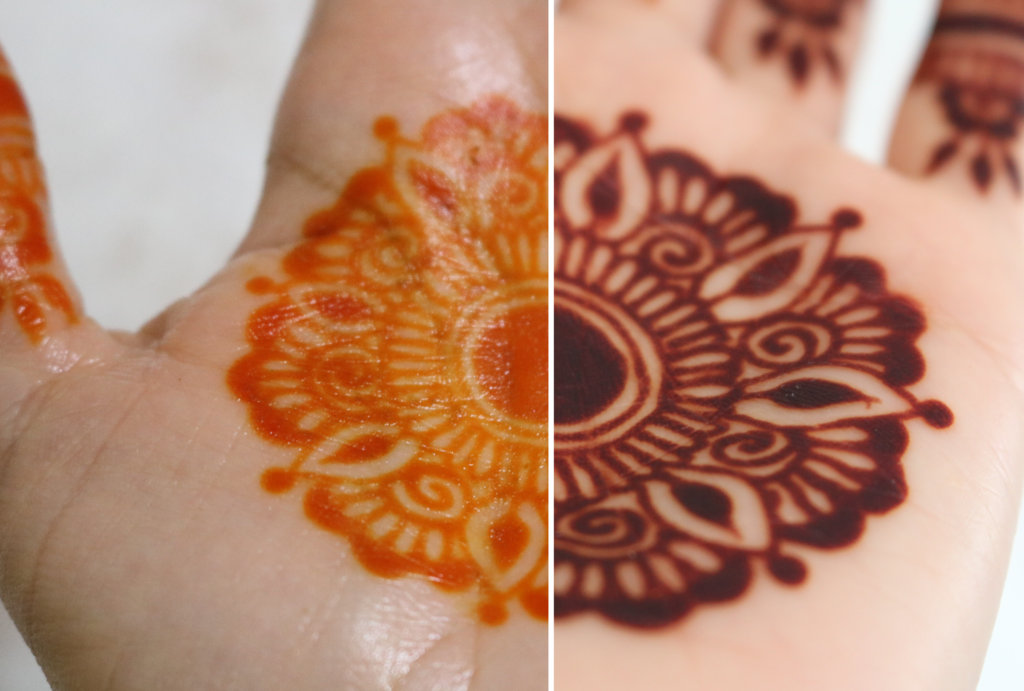Aftercare refers to taking care of the fresh henna stain to ensure it deepens to its full potential. Proper aftercare is the KEY to achieving a deep henna stain. Every aftercare step is based on the science of henna stains so let's learn about that first.
How does Henna stain the skin?
Henna leaves/powder contain a molecule called lawsone which is the dye molecule that makes henna stain the skin. In order to "activate" the dye, henna powder needs to be mixed with lemon juice/water and essential oil that help bring out the dye molecule; this is called the dye release process and it takes about 12 to 24 hours. Once this process is complete, henna paste is mixed well, strained, and filled in cellophane cones.
When henna paste is applied to the skin, the dye molecule binds with keratin, a protein that makes up the outer layer of the skin (epidermis). The binding of henna with the skin changes the colour of skin to orange. The longer the henna paste stays in contact with the skin, the more intense the orange stain becomes as the dye molecule penetrates deeper through the skin layers. As shown in the picture below, when henna paste is removed after 8 hours, the fresh stain is bright orange.

How does the orange henna stain turn dark brown? This happens by the process of oxidation. When the fresh henna stain is exposed to air, it reacts with the oxygen and turns darker (just like a slice of apple would). Over 24 to 48 hours the stain continues to oxidize and turns darker. During this time it is important to take care of the henna stain so it can develop to its full potential. The pictures below show stain progression of henna (top) and jagua henna or hengua (bottom).


Although aftercare is super important, the colour of mature henna stain is determined by other factors as well. These include skin tone, skin condition/texture, body temperature, hormone levels, etc. In addition, the stain varies depending on which area of the body henna is applied to. Henna always stains darker on thick skin. For example, henna stain on the palms will be darker than the henna stain on arms.
Lastly, the henna design also makes a big difference in the final stain. Bold henna elements such as leaves or fills deposit more henna on the skin and result in a darker stain compared to intricate elements like lines, humps, and shading. Henna artists usually make designs utilizing both intricate and bold elements as shown in the pictures above.
Henna Application & Aftercare
The darkest & long-lasting henna stain is achieved by following proper application and aftercare instructions. Here's how you can get the best stain:
1) Thaw henna cone for 30 minutes at room temperature before use. Cleanse and dry skin before application. Do NOT apply lotion or cream because this will prevent the henna from bonding to the skin properly.
You may notice that the henna paste is darker at the tip of the cone. This happens because of a chemical reaction between the metal pin and the henna paste. Just squeeze out the darkened paste on a tissue before use.
2) Apply henna and keep very still to prevent the wet henna from smudging. Dry it completely.
3) The dried henna paste needs to stay in contact with the skin for 8 to 12 hours. Since the dry paste flakes off easily, there are two ways to keep it stuck to the skin:
Option 1 - Apply sugar sealant, a sticky mixture that is applied on top of the dried henna. You can make it by mixing 1 tsp of sugar with 2 tsp of water/lemon juice. Spray it on the skin using a fine mist spray bottle or dab over the skin using a cotton ball/pad. This will take some time to dry (you can tell it is dry when it stops being sticky). The picture below shows the glistening/glazed effect this gives. It creates a film over the dried henna paste, preventing it from flaking away.
Once completely dry, you can wrap some toilet paper around (but not too tightly) and rest your hand/feet. Some people wear stockings instead.

Option 2 - Apply medical tape like Mefix to keep henna adhered to skin. You can find medical tape at your local pharmacy or on Amazon. The tape needs to be cut accordingly to cover all areas of the henna design (see picture below).
This option is mess free and especially great for kids who have a hard time keeping henna on for a long time. However, It is not recommended for brides as the tape sometimes causes sweating of palms and may result in a smudged stain.


4) Keep henna on skin for 8 to 12 hours and stay warm as warmth makes the stain darker. Keep henna warm by wearing stockings or wrapping in toilet paper (but not too tightly). It is best to keep henna on overnight as you get extra warmth from your comforter/blanket and you don't have to worry about getting any work done.
Warmth speeds up and intensifies the bonding of dye molecules with the skin cells. What if you can't keep the henna on for so long? Henna will stain the skin even if it is kept on for 4-6 hours but 8-12 hours is recommended for the BEST stain.
5) It's finally time to remove the henna! Please DO NOT wash it off. Scrape the henna paste off using a spoon or butter knife. If this is difficult to do because of the sugar sealant, apply coconut oil (or aftercare balm) on the henna paste and then scrape it off.
If you used the medical tape option, simply peel off the tape. Most of the henna paste will come off with the tape. You can scrape off the rest as described above.
6) If you haven't already, apply coconut oil or an aftercare balm and keep the area warm ex. wear socks.
Once again, warmth plays an important role in speeding up and intensifying the oxidation process. Apply oil/balm multiple times every day to make the stain last longer. Keeping the stain moisturized will prevent the stain from fading away quickly.
7) Avoid contact with water for 24-48 hours. Exposure to water & soap prevents the stain from deepening to its full potential. Wear gloves if exposure to soap cannot be avoided.
Aftercare definitely requires hard work and patience but the end result is worth it! :) If you can't follow some of these steps, don't worry, henna stain will still darken (just not to its full potential).
How long does the Henna Stain last?
Henna stains can last for 1 to 2 weeks in good condition and then slowly fade away. Henna penetrates through the layers of the skin, staining the top layer (epidermis) the most and staining each layer underneath lesser than the layer above. The epidermis renews itself by losing surface cells, bringing new cells from the layer beneath to the surface. This means that when cells on the surface with the darkest stain shed off, we see the cells underneath which are stained less. Therefore as the skin continues to shed, we see the henna stain fading away.
To make the henna stain last longer, keep the skin moisturized using lotion, oil, or aftercare balm. This will slow down the process of natural exfoliation. Also, wear gloves when long exposure to soap/cleaning solutions can't be avoided.
Luxe Organic Henna is committed to bringing you the best organic henna products for hair and body art. Our products are made with organic ingredients and contain no chemicals. We get our supplies only from reputable suppliers who strictly adhere to regulatory standards and have gone through testing and organic certification for their products.

